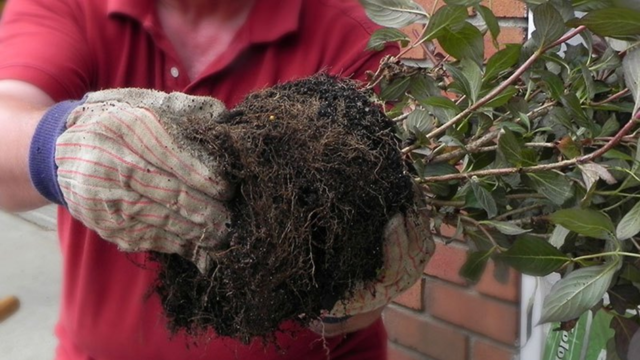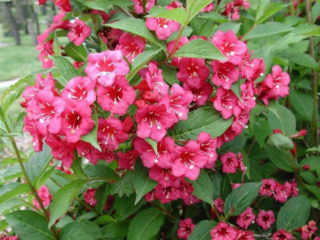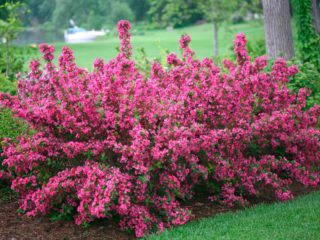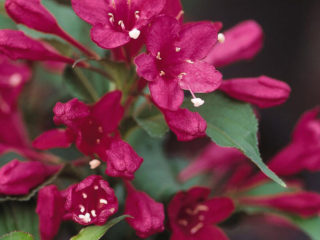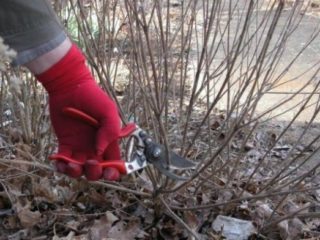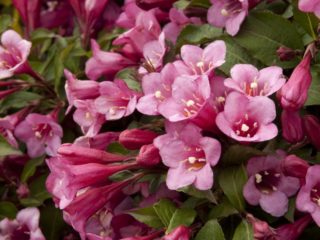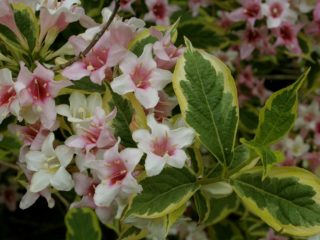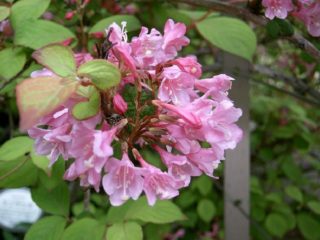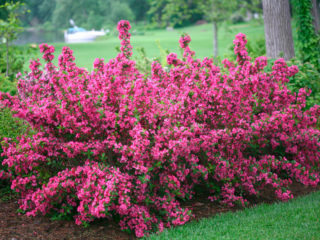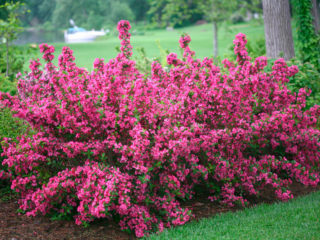Content
Planting and caring for weigela in the open ground must be carried out correctly so that this shrub feels good in gardens in Russia. Creating optimal conditions for weigela is not so difficult if you know what this eastern guest is used to.
Features of growing weigela
When choosing a suitable location, following planting rules and conscientious care, weigela will respond with picturesque flowering, which is confirmed by numerous photos taken by amateur gardeners.
What Weigela likes and doesn’t like
Weigela prefers open, well-warmed sunny areas, protected from cold winds.These characteristics of the site for planting weigela must be taken into account first, because it will be impossible to influence them in the future. The quality of the soil is also of great importance for weigela: it should be light, water- and breathable, and fertile. The soil is slightly alkaline or neutral. Shrubs should not be planted in lowlands or in places where groundwater is located too close to the surface, since the delicate root system of the plant does not tolerate excess moisture.
How to preserve weigela seedlings before planting in the ground
If weigela seedlings were purchased in winter, then before planting in open ground you need to create certain conditions for them. To prevent plants from growing prematurely, they are stored in a cool place without access to light. There are several ways to preserve seedlings until spring:
- The cuttings can be buried in the area by placing them on the ground at a slope and covering the root system and crown with soil.
- Wrap the seedlings in thin plastic film, make holes in it for air access, wrap it in newspaper, secure the bundles with rubber bands, place them in plastic boxes and put them in a cool place, for example, on a glazed balcony or in a cold cellar.
- Store the cuttings on the bottom shelf of the refrigerator.
- If the seedlings are large, place them in containers with moistened sand.
What can be planted next to weigela
Abundantly flowering weigela looks great in solitaire plantings, but it can be successfully combined with other beautifully flowering shrubs or flowers. Plants for such compositions should be selected taking into account the timing and duration of flowering, size, growing conditions and care characteristics.Weigela looks picturesque even during the period between flowering, so other flowering crops will look good against the background of its foliage. Weigela looks picturesque in single plantings against the backdrop of large trees or on lawns. The combination of weigela with conifers, for example, juniper, cypress or larch, looks very impressive. They also combine it with barberry, rhododendron, yew berry, lilac, and various herbaceous plants. In hedges, weigela will be complemented by mock orange, kolkvitsia, deutzia, and beanweed. You can plant it under tall trees - this technique is often used by landscape designers to create multi-level compositions from plants of different heights. It should be noted that excessive shading has a bad effect on the flowering of weigela.
Where and how to plant weigela
The most important thing when growing weigela is to choose a place that is suitable in terms of lighting and protection from drafts and to follow the timing and rules of planting and care. Weigela will respond to an unfavorable location or gross violation of agricultural technology by sparse flowering or its complete cessation.
When to plant weigela in the ground: in spring or autumn
In order for the heat-loving weigela to take root and gain strength before the onset of winter cold, it should be planted in the ground in the spring (March-April). By this time, the earth has already warmed up sufficiently, but the seedling has not yet begun to grow. If you purchased a cutting with a closed root system, you can plant it in a permanent place before June, the main thing is to try to do it before the intense heat.
Choosing a suitable location
Considering the natural needs of weigela, it is best to choose a place for planting it in elevated areas, where flooding is excluded. The place for it should be well lit and protected from strong cold winds, which can damage flowering. It is permissible to plant this shrub in the shade of tall trees with a loose crown, but it should be taken into account that in insufficient light the weigela will not bloom so abundantly and brightly.
What kind of soil does weigela like?
Weigela will grow well in slightly alkaline or neutral light and fertile soils. Loams are best suited for it. Weigela Middendorf feels comfortable in slightly acidic peat soils. The main thing for the root system of this plant is the water and breathability of the substrate.
How to plant weigela
Seedlings aged three years are best suited for planting, since the younger the weigela, the better it takes root. The cuttings are planted in open ground in several stages:
- A nutritious soil mixture is prepared from turf, humus and sand or from fertile soil mixed with compost. For each seedling, 100–130 g of nitrophoska is added to the mixture.
- Dig planting holes about 0.5 m long and wide and 20 cm deep than the height of the seedling's earthen ball. The denser the soil, the larger the size of the hole should be; sometimes its depth can reach 1 m.
- Drainage is poured onto the bottom - broken brick or gravel sprinkled with sand; the layer should be approximately 15 cm.
- The cuttings are pulled out of the container and the roots are carefully examined, the rotten areas are cut off, and the plant is carefully placed in the center of the hole.
- A seedling with an open root system is treated with a root formation stimulator before planting.The prepared nutrient soil mixture is poured into the bottom of the hole and the roots of the plant are carefully distributed.
- The plant is buried so that the root collar is not too deep.
- The soil is compacted so that there is no air left between the roots, watered and topped up with nutritious soil mixture.
- The seedling is mulched with manure, sawdust or peat.
- Young plants are shaded from direct sunlight for several days after planting.
Weigela of large varieties is recommended to be planted so that the distance between the bushes is at least 150 cm. For varieties of medium height, 80 cm is sufficient. When planting in trenches, plants can be placed every 50 cm.
How to transplant weigela to another place
If there is a need to transplant weigela, you must act very carefully and with great caution, since an adult plant does not take root well in a new place. A transplant is justified if the initial location was chosen incorrectly and there is no way to improve the situation in less radical ways.
When is the best time to replant weigela?
Just as in the case of planting cuttings in open ground, it is recommended to replant an adult plant in April, when the soil has already thawed and the growing season has not yet begun. Transplanting weigela in the fall is extremely undesirable, since in this case its fragile root system will not have time to adapt to the new location before the onset of winter cold.
Selecting a location and preparing the soil for weigela
The place for transplanting weigels is selected according to the same criteria as for planting new plants:
- plenty of sunlight and protection from cold winds;
- lack of stagnation of moisture in the soil;
- light fertile soil.
The site for weigela has been prepared since the fall.The plant prefers slightly alkaline soil, so if the soil is acidic, it is limed. Weigela Middendorf feels good in a slightly acidic substrate; if necessary, the soil for it is enriched with peat. Sandy loam, which loses moisture too quickly, is mixed with clay and peat.
If it is not possible to avoid planting shrubs on heavy soils prone to waterlogging, sand, brick chips, fine gravel are added to them, and sometimes drainage systems are built.
The substrate is fertilized with compost or manure, as well as complex mineral fertilizers. All components that need to be added to the soil are mixed, scattered over the area and dug onto the bayonet of a shovel.
If the site is too low, small mounds are made, which can be easily formed into an alpine hill.
In the spring, about 14 days before planting, pits are prepared.
How to transplant weigela in spring
The technologies for transplanting an adult plant and planting a seedling in open ground are practically the same: they also prepare a nutritious soil mixture, dig and drain planting holes, bury, water and mulch the newly planted plant.
Replanting a bush has the following distinctive features:
- In the spring, the bush is very carefully dug around the perimeter, trying not to damage the root system, and pulled out along with the earthen lump.
- The bush is placed in a hole so that its root collar is at the same level as in its previous place.
- Immediately after transplantation, cut off all damaged, dry and old branches.
Further care for a bush that has been planted to a new place is also no different from caring for other weigela plants, with the only difference being that such a plant must be prepared for winter especially carefully.
How to care for weigela
If weigela is planted correctly, caring for it will not be too labor-intensive, and already from the age of 3, the young shrub will delight you with numerous delicate flowers twice a year.
The main care for this type of plant consists of watering, fertilizing, pruning, loosening and preventing diseases and pests. Of particular importance in the climate of the middle zone is the preparation of weigela for winter - mulching the tree trunk and constructing a winter shelter.
Watering schedule
This shrub does not need a lot of moisture and does not tolerate stagnant water at the roots. Abundant watering is needed only once per season, in early spring, immediately after the weigela opens. If after wintering the plant looks dried out and lifeless, moderate watering is still carried out, since in most cases the plant recovers and can bloom in the same season.
In summer, in hot weather, plantings are watered once every 7 days; on ordinary days, it is enough to moisten the soil no more than twice a month. If the bush is mulched, you can water it even less often.
If a dry autumn has set in, moderate watering continues throughout the entire season, until the first frost. Pre-winter watering not only nourishes the root system, but also prepares it for winter.
How to feed weigela in spring and summer
If the place for weigela is properly prepared and all the necessary fertilizers have been applied, weigela need not be fed for two years after planting. Next, the plant needs fertilizing to stimulate vegetation.Caring for weigela in early spring begins even before the snow completely melts. Then the first fertilizing is done: urea, potassium salt, and superphosphate are scattered around the bushes. With melt water, the nutritional components of fertilizers reach directly the root system of plants.
In order for the weigela to bloom profusely and for the young shoots to strengthen for winter, it is recommended to carry out a second feeding in late spring, when buds form on the plant. At this time, apply 2 tbsp under each bush. l. superphosphate.
In between these main feedings, it is useful to apply natural fertilizers: mullein, wood ash, humus, compost.
If desired, you can spray the crown with special solutions for foliar feeding, which are sold in specialized stores or garden centers. It is enough to carry out such fertilizing 2–3 times per season.
Trimming
Weigela needs sanitary, formative and rejuvenating pruning. In early spring, remove damaged shoots; in mid-summer, after the completion of the first flowering, the crown is formed and the inflorescences are cut off. Autumn pruning of weigele is not carried out so as not to damage the shoots on which flower buds form.
Pests and diseases
With good care, weigela rarely gets sick, but insect pests can pose a danger. Most often it is attacked by aphids, caterpillars, thrips and spider mites. Intense heat and low humidity increase the risk of these insects attacking crops. To combat them, toxic drugs are used, for example, Keltan, Nitrafen or Rogor.To completely get rid of insects, treating infected bushes twice with one of these insecticides is sufficient. More environmentally friendly remedies are water infusions of wormwood, hot pepper, garlic or potato tops.
Sometimes the roots of the bush are affected by the larvae of the cockchafer or mole cricket. Their presence can be suspected by yellowing and wilting of the leaves shortly after planting the seedling. Aktara or Karbofos solutions will help get rid of these pests.
If weigela plantings have suffered from bacterial or fungal diseases, such as gray rot, rust or spotting, they should be treated with Bordeaux mixture.
For preventive purposes, when the leaves bloom, the bush should be sprayed with a 3% Topsin solution.
Conclusion
Planting and caring for weigela in open ground is not difficult. The shrub is an unpretentious species and requires no more attention than most flowering crops. Caring for this plant is aimed at improving flowering; its decorative qualities can surprise even an experienced gardener. The wide possibilities for using weigela in landscape design make it increasingly popular among gardeners in our country, regardless of the region, and if the rules of cultivation and good care are followed, the abundant bright flowers of weigela will be a source of special pride for the garden for several decades.


